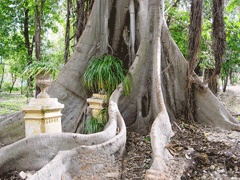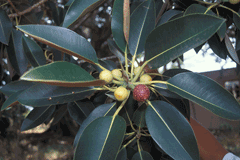 |
|
http://commons.wikimedia.org/wiki/User:Esculapio |
 |
| http://www.hear.org/starr/ |
Translate this page:
Summary
Physical Characteristics

 Ficus_macrophylla is an evergreen Tree growing to 35 m (114ft 10in).
Ficus_macrophylla is an evergreen Tree growing to 35 m (114ft 10in).
See above for USDA hardiness. It is hardy to UK zone 10. The species is hermaphrodite (has both male and female organs).
Suitable for: light (sandy), medium (loamy) and heavy (clay) soils. Suitable pH: mildly acid, neutral and basic (mildly alkaline) soils. It can grow in semi-shade (light woodland) or no shade. It prefers moist soil.
UK Hardiness Map
US Hardiness Map
Synonyms
Plant Habitats
Edible Uses
The fruit is 18 - 25mm in diameter[265].
References More on Edible Uses
Medicinal Uses
Plants For A Future can not take any responsibility for any adverse effects from the use of plants. Always seek advice from a professional before using a plant medicinally.
None known
References More on Medicinal Uses
The Bookshop: Edible Plant Books
Our Latest books on Perennial Plants For Food Forests and Permaculture Gardens in paperback or digital formats.

Edible Tropical Plants
Food Forest Plants for Hotter Conditions: 250+ Plants For Tropical Food Forests & Permaculture Gardens.
More

Edible Temperate Plants
Plants for Your Food Forest: 500 Plants for Temperate Food Forests & Permaculture Gardens.
More

More Books
PFAF have eight books available in paperback and digital formats. Browse the shop for more information.
Shop Now
Other Uses
It has a special relationship with fig wasps - figs are only pollinated by fig wasps, and fig wasps can only reproduce in fig flowers. Provides food for the Grey-headed Flying-fox and the Wompoo Fruit-dove. Shade tree for livestock. The fibres were traditionally used for fishing nets in Australia.
Special Uses
References More on Other Uses
Cultivation details
Grows well by the sea[260]. This species is not very cold tolerant, probably tolerating temperatures down to about -3°c[260]. It succeeds outdoors at Tresco on the Scilly Isles though it is unlikely to succeed anywhere on mainland Britain. 193109 200
References Carbon Farming Information and Carbon Sequestration Information
Temperature Converter
Type a value in the Celsius field to convert the value to Fahrenheit:
Fahrenheit:
The PFAF Bookshop
Plants For A Future have a number of books available in paperback and digital form. Book titles include Edible Plants, Edible Perennials, Edible Trees,Edible Shrubs, Woodland Gardening, and Temperate Food Forest Plants. Our new book is Food Forest Plants For Hotter Conditions (Tropical and Sub-Tropical).
Shop Now
Plant Propagation
Other Names
If available other names are mentioned here
Moreton Bay Fig
Native Range
AUSTRALASIA: Australia (New South Wales (east), Queensland (east), Lord Howe Island)
Weed Potential
Right plant wrong place. We are currently updating this section.
Please note that a plant may be invasive in one area but may not in your area so it’s worth checking.
Conservation Status
IUCN Red List of Threatened Plants Status :

Growth: S = slow M = medium F = fast. Soil: L = light (sandy) M = medium H = heavy (clay). pH: A = acid N = neutral B = basic (alkaline). Shade: F = full shade S = semi-shade N = no shade. Moisture: D = dry M = Moist We = wet Wa = water.
Expert comment
Author
Desf. ex Pers.
Botanical References
200265
Links / References
For a list of references used on this page please go here
Readers comment
| Add a comment |
|
If you have important information about this plant that may help other users please add a comment or link below. Only comments or links that are felt to be directly relevant to a plant will be included. If you think a comment/link or information contained on this page is inaccurate or misleading we would welcome your feedback at [email protected]. If you have questions about a plant please use the Forum on this website as we do not have the resources to answer questions ourselves.
* Please note: the comments by website users are not necessarily those held by PFAF and may give misleading or inaccurate information.
To leave a comment please Register or login here All comments need to be approved so will not appear immediately.
|
Subject : Ficus_macrophylla
|
|
|
|